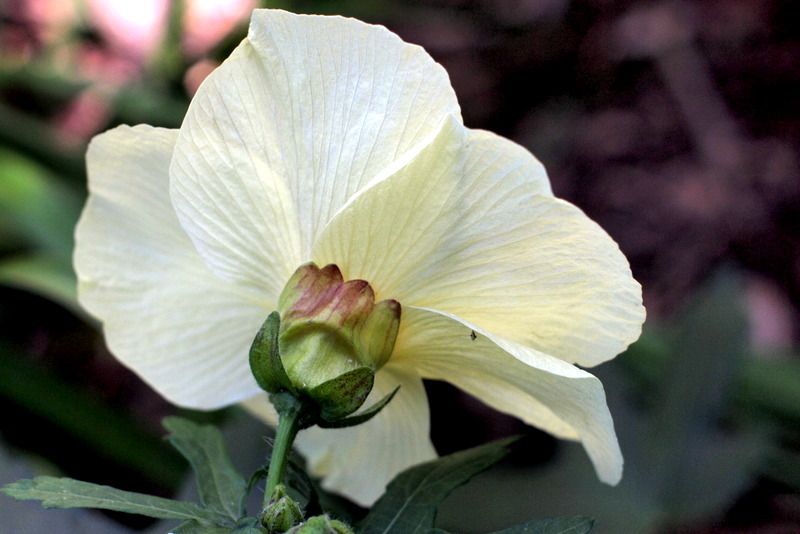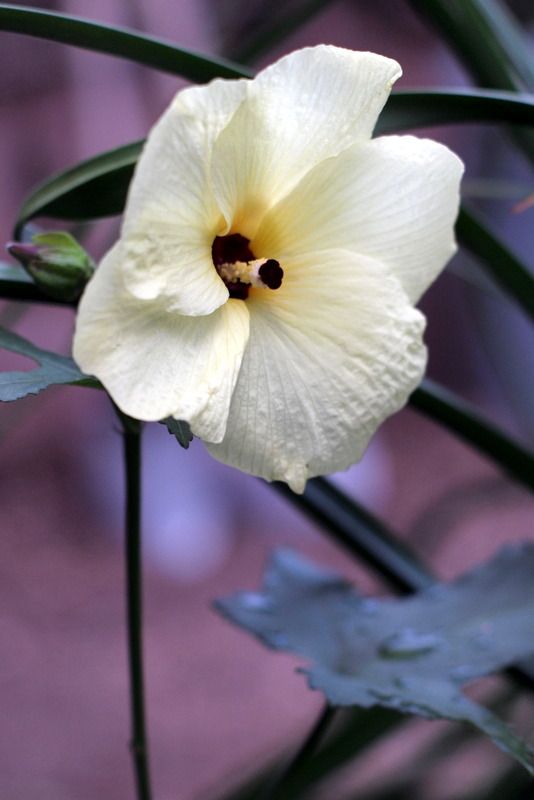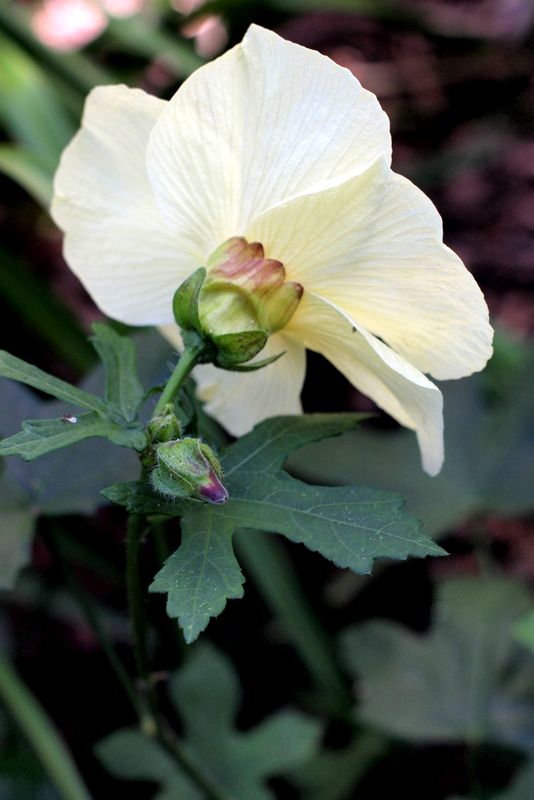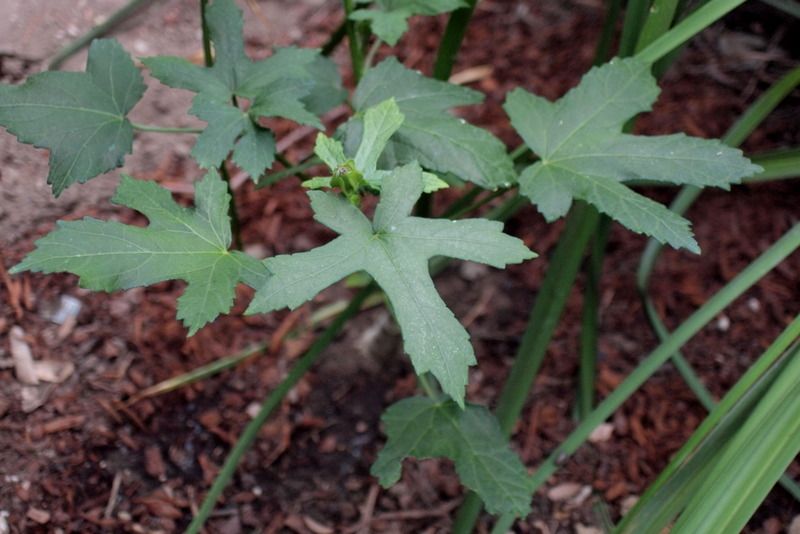And I mean in the specific sense of mail-ordering one plant and then receiving a different one. With plants, impostors and mix-ups can be difficult to detect. It’s not like mail-ordering a rug, which when it arrives two weeks later it’s immediately apparent that it’s the wrong color or size. In the slow-paced world of plants and gardens, the reckoning can come as much as a year later and even years beyond.
Take, for example, my hibiscus whose first bloom opened this morning.

I’m not going to name the excellent nursery from which I ordered this plant, because I’d hate to dissuade anyone from diving into their extensive catalogue listings. Everything else I’ve ordered has been accurately labeled. Nurseries with cutting-edge catalogues that try to keep the boundless appetites of plant fanatics satisfied while still managing to stay in business are bound to have a few slip-ups like this. And on the whole, the drama of mistaken identity adds undeniable excitement (such is my life).
The plant I ordered was Hibiscus moscheutos var. incanus. It was one of those mid-January, summer-starved, daydreamy purchases. (January 2012.) I was probably attracted to its silvery leaves and tolerance for dry soil. Like a cistus, its flowers were supposed to be white, not yellow, with a maroon throat. Not that the color of the bloom was important. Silvery leaves were the main attraction.


What opened today was a hibiscus with lovely, soft yellow flowers and dark green, okra-like leaves.

From the very beginning, the green leaves were a puzzle that indicated something might be amiss. Maybe they’ll change to silver when the plant matures, I reasoned. But the yellow bloom, which is slightly deeper in color than the photos depict, is the tipoff that this is something other than the hibiscus I ordered. From the nursery’s catalogue, it looks like possibly Hibiscus aculeatus, which they also carry, a native hibiscus from southern U.S. Or it could be Abelmoschus manihot.
Whatever it is, I love it. The flowers are thankfully not hybrid-huge in size but still a substantial 3 inches across, and the proportions of leaf and flower hold the promise of a graceful flowering shrub for summer. The only problem is, if this is Hibiscus aculeatus, it thrives in bogs and soggy ditches, conditions completely foreign to my garden.

For now I am carrying an extra gallon or so of water to this hibiscus, situated way in the back near the compost pile, where the hose is unable to reach this lovely mistake. About a foot and a half in height now, we’ll see how it fares by late August or so, assuming a disciplined watering program can be maintained — a big assumption.

At least your mistake plant was a nice one has now found a wonderful new home. When we first bought our house I want a relatively low evergreen at the house corners. I selected the ‘Otto Luyken’ cherrylaurel (Prunus laurocerasus ‘Otto Luyken’ which tops out at about four feet. Purchased plants from a local reputable nursery. Ten years later the cherrylaurels are green and attractive, but they are 11 feet tall. They are the species Prunus laurocerasus, not Otto Luyken. Mistakes happen, and sometimes you just have to roll with the punches, or as you have done, look on the positive side and welcome a new, if unexpected, plant to the landscape. I really enjoy your site and all the wonderful photos. Great reading and great viewing. Thanks.
Bob, I love it when a post elicits stories like yours, and was hoping describing this account of a harmless swapping of plants would do just that. I know that with, for example, hedges and trees, misidentified plants can be disastrous. Thanks so much for your thoughtful comments!
That happened to me recently in a local nursery. I thought I bought a white and red Asiatic lily but when it finally bloomed it was bright orange. NOT what I had wanted. I’m sure it was an honest mistake, just like yours was. But your plant is beautiful no matter what it is exactly.
Gerhard, I know, I got off easy! And I get that color switcheroo a lot with tulip bulbs too.
Oh dear. I hope it thrives in your environment as it’s a pretty plant but Jeesh…. I too have had dreadful tulip mistakes. I’d planned on an early flowering pink/magenta tulip extravaganza to go with my PJM Rhododendrons and what I got was an orangy tulip that clashed horribly with the rhododendron blossoms… had to dig them out and get rid of them.
Oh, Deanne, that does sound atrocious. And the worst part is, there goes another spring. The plan was good, but the supplier dropped the ball. In the case of tulip bulbs, I would definitely “out” the offending suppliers and list names, so we can avoid them.
I think you should contact the supplier…you never know, you might find out something interesting. I thought I got a different sedum fom Plant Delights a few years back, and I was curious to find out what it actually was. Turns out, Hab Gray has been known to flower more of a light pink in the north, epecially during milder summers, while it’s more of a yellow in the south. (Both being more like distinct shades of cream than true colors.)
I was actually surprised to get a quick response back from them-and impressed that the follow-up answer included a forwarded explanation fom Tony Avent himself. Kinda cool. 🙂
Kim, that would be the only way to know for sure. That’s a great suggestion, thanks.
I’m really partial to yellow flowers, but grey foliage and white blooms is not always a good look with yellow flowers and green foliage. I am very partial to yellow flowers , and would do what I needed to for this to work.
It can be aggravating when you get a mix-up after spending a chunk of change on a mail-order plant, although your mix-up is at least quite lovely in its own right. We Austin garden bloggers have a monthly plant swap, and often I end up going home with a handful of tiny seedlings whose identity I’ve completely forgotten. Then you have the challenge of deciding where to plant them while you wait to see what you’ve gotten!
It sure looks like Abelmoschus manihot to me. Although it is not hardy for us, it drops lots of seeds and I usually get new ones every year. They love our heat and humidity and make fertile seed pods by the end of summer. The color of the flower reminds me of moonlight. When I was in retail and a plant turned out to be mis-labeled, I gave the customer the option of keeping it and getting a 50% store credit on the original price for the imposter, or bringing the plant back for a full refund. The first option was usually the resolution.
@Kathy, if I wasn’t in that weird January SAD mood, I doubt I would have ordered a species hibiscus — just not something I usually go for. You know what kind of hibiscus we see here in LA! But this one is lovely, so maybe I’ll try to get the original silvery one too.
@Pam, you know well enough that Austin gardens can’t be blase about misidentified plants — the Death Star demands precise labeling!
@Les, thanks for the input. I hope it’s hot and humid enough here. Moonlight is exactly right. I hope it gets big so it can really shine! 😉 This week I’ll probably contact the nursery to confirm the ID.